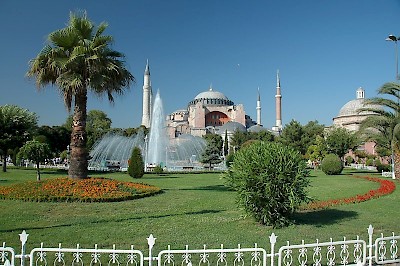Constantinople, Augusteôn Square
Augusteôn Square ("Square of the Empresses"): central square in ancient Constantinople.

Augusteôn Square was one of the oldest parts of Constantinople. When Byzantium had just been founded and was still a Greek town, there must have been a central square, which was - probably in the Hellenistic age - surrounded by four porticos (stoas). It was called Tetrastôn, the place of the four porticos. In the neighborhood, one could find a sanctuary of Tyche and Rhea, and we know that there was a famous statue of Apollo as well.
When Septimius Severus rebuilt the city in 203, the new main road of the city, the Mese, was built; it started here and led to the west, where it continued as Via Egnatia. During the reign of Severus, the Baths of Zeuxippus were built as well. They were at the site of the fountain on modern Sultanahmet Meydanı, which is essentially the same place as the Tetrastôn. The name "Augusteôn Square" may also date from this age, as the Severan empresses were very important. Alternatively, it can also be assumed that the name postdates Constantine's refoundation of the city, although this does not explain the plural. In any case, there was one statue of Eudoxia I - the object of a serious riot in 404 CE - but there may have been more.

In the age of Constantine, Augusteôn Square was surrounded by other, new buildings. The Baths of Zeuxippus in the southwest were expanded; in the northeast, the Church of Divine Wisdom (Hagia Sophia) was built, with a small palace for the patriarch. In the southeast was the Senate or Magnaura, which was the town's city council. The Chalke, or Bronze Gate, gave access to the royal palace; it was in the southern corner of Augusteôn Square.
Milion
In the west was the monument that was called Milion (the Golden Milestone; Μίλιον), on which the distances to the cities of the Empire were recorded. It consisted of a dome supported by four arches, and may have looked a bit like the Arch of Janus Quadrifrons in Rome, which was also constructed by Constantine. On top of it was a group of statues: Constantine, his mother Helena, a cross, and a personification of the city. Justinian added a sundial.
Equestrian Statue of Justinian
After the end of the Persian War, the Column of Justinian was added to Augusteôn Square (543). Procopius offers a long description:
In the Augusteôn there is a structure of stones, which is made up of not less than seven courses, laid in a rectangle, all fitted to each other at their ends, but each course being narrower than that beneath, and set back, with the result that each of the stones becomes, from the way it is set, a projecting step, so that people assembled there sit upon them as upon seats. And at the top of the stones there rises a column of extraordinary size, not a monolith, however, but composed of large stones in circular courses, cut so as to form angles on their inner faces, and fitted to one another by the skill of the masons. And finest brass, cast in panels and garlands, covers the stones on every side, both serving to bind them securely, and covering them with adornment, and giving the shaft throughout, but particularly at the base and the capital, the appearance of a column. ... And on the summit of the column stands a gigantic bronze horse, facing toward the east, a very noteworthy sight. He seems about to advance, and to be splendidly pressing forward. Indeed he holds his left foot in the air, as though he were about to take a forward step on the ground before him, while the other is pressed down upon the stone on which he stands, as if ready to take the next step; his hind feet he holds close together, so that they may be ready whenever he decides to move. Upon this horse is mounted a colossal bronze figure of the Emperor [Justinian]. And the figure is habited like Achilles, that is, the costume he wears is known by that name. He wears half-boots and his legs are not covered by greaves. Also he wears a breastplate in the heroic fashion, and a helmet covers his head and gives the impression that it moves up and down, and a dazzling light flashes forth from it. ... And he looks toward the rising sun, directing his course, I suppose, against the Persians. And in his left hand he holds a globe, by which the sculptor signifies that the whole earth and sea are subject to him, yet he has neither sword nor spear nor any other weapon, but a cross stands upon the globe which he carries, the emblem by which alone he has obtained both his Empire and his victory in war. And stretching forth his right hand toward the rising sun and spreading out his fingers, he commands the barbarians in that quarter to remain at home and to advance no further. So much, then, for this statue.note